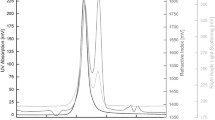Abstract
Oxidant toxicity of indole was demonstrated by the induction of alkylhydroperoxide reductase subunit C (AhpC) in Escherichia coli K12 and by the constitutive overproduction of AhpC in a variant of E. coli JM109 with enhanced resistance to indole. Oxidant toxicity was also indicated in an indole-adapted variant of Brevibacterium flavum by the indole-inducible overproduction of a novel 36-kDa protein with N-terminal sequence similarity to proteins involved in superoxide and singlet oxygen resistance. It is proposed that indole dissolved in membrane lipids, which caused membrane derangement and enabled direct interaction of redox-cycling isoprenoid quinones and dioxygen, resulting in the generation of superoxide. ¶A direct indication of membrane derangement in E. coli may be the indole-inducible overproduction of spheroplast protein y (Spy).
Similar content being viewed by others
Author information
Authors and Affiliations
Additional information
Received: 5 July / Accepted: 1 October 1999
Rights and permissions
About this article
Cite this article
Garbe, T., Kobayashi, M. & Yukawa, H. Indole-inducible proteins in bacteria suggest membrane and oxidant toxicity. Arch Microbiol 173, 78–82 (2000). https://doi.org/10.1007/s002030050012
Issue Date:
DOI: https://doi.org/10.1007/s002030050012




